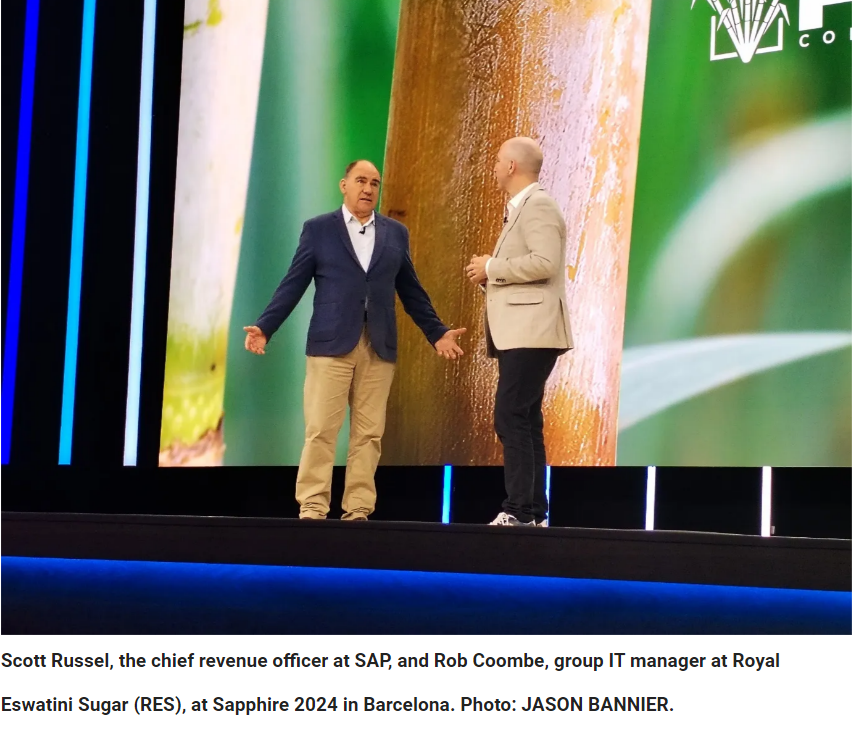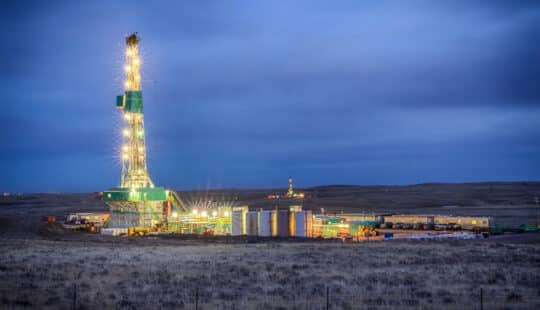Royal Eswatini Sugar (RES) provided a superb case study at the recent Sapphire conference in Barcelona, write ARTHUR GOLDSTUCK and JASON BANNIER.
Agriculture in Africa is being transformed by artificial intelligence, but there is still one element it cannot replace.
Despite dramatic technological advances in the sector in recent decades, the role of the farmer remains indispensable. This was a message delivered, surprisingly, at a recent conference in Europe, by a world leader in the field – from Eswatini.
Rob Coombe, group IT manager of Royal Eswatini Sugar (RES), took part in a keynote speech at the Sapphire conference hosted by software giant SAP in Barcelona, with a case study that encapsulates 21st century farming.
“You really can’t take the farmer out of farming,” Coombe told us during Sapphire. “So much depends on the farmer’s intuition. Farming is incredibly scientific, with various measurements and readings. However, even with the best data, natural elements can change outcomes drastically.”
The sugarcane producer uses drones and satellite imagery to enhance productivity and efficiency with SAP software.
SAP’s S/4HANA system is a leading tool for enterprise resource planning in enterprises, and is used by 85 of the 100 largest companies in the world.
In a keynote address, SAP chief revenue officer by Scott Russell said: “The reality is that, with business AI imbedded in your business, the opportunities are endless.”
 The biggest opportunity at present, said Coombe in response, was improving the bottom line.
The biggest opportunity at present, said Coombe in response, was improving the bottom line.
“We have reduced the cost of IT by 15%,” he told the audience of several thousand delegates. “We’re spending more with SAP, but less overall.”
Coombe has been at RES for more than 12 years, but has worked with SAP systems since 1991. In that time, he said, the way technology is implemented has changed.
He told Business Times: “The two big things are always people and data. People are immune to change, so getting the change in people’s mind is key. And getting your data sorted is equally important. When your data is not right, it doesn’t matter what the system is, you get a lot of rubbish out of it.”
RES applies AI and Machine Learning (ML) to 15 years of satellite imagery to create a “digital twin” of its operations, in collaboration with SAP systems.
“This helps us predict the yield and manage cash flow and budgeting more accurately. By integrating this data with SAP Intelligent Agriculture and S4/HANA, RES can monitor crop health in real-time and make necessary adjustments. We don’t have to wait until harvest to see that there is a problem; we can see it on a day-to-day basis.”
RES is using historical climate data and forward-looking weather data, combined with ML models, to predict future conditions, aiding in better planning and simulation. It is deploying drones for a range of agricultural tasks, enhancing both efficiency and precision.
“Instead of getting the guys in there, we send out a drone, and do an analysis with AI. Scouting – going out to look for pests and diseases – will now become an electronic thing, so you get quicker responses.”
For climate monitoring, RES is using historical climate data and forward-looking weather data with ML models to predict future conditions, aiding in better planning and simulation.
“We are building a model with Swiss partners to use forward-looking weather data to improve our predictions. After we finish with S4, we are moving into the planning side of it, by the end of this year. This will help us determine the anticipated crop, the amount of sugar we will produce, the people needed, tractor hours, and diesel consumption.”
Instead of randomly fertilising fields, the operation use satellite data to determine which areas need more fertiliser.
RES uses sensors to predict vibration and heat, allowing it to fix machines before they break. This information is fed into the SAP software to manage maintenance tasks efficiently.
The transition to public cloud technologies has simplified aspects of operations.
“In the old SAP days, it was a lot more difficult,” says Coombe. “Being on the public cloud, technology-wise, it has been easy. The amount of content available to us from a customer perspective to learn what to implement, how to implement, and so on, is completely different to what it was in the early 2000s.”
This change has also facilitated the rapid onboarding of new employees.
“We employed some graduate trainees, and two days later they’re working. You could not do that in the past. They can bring their Java, and scripting tools, and start just start working.”
RES’s strategic approach involves engaging all organisational levels.
“It was key to start at the top, but also work hard at the bottom, and then the frozen middle melted. At the bottom, we have super users. We mentor them once a month, addressing their problems and quickly dealing with them.”
RES is also using generative AI with the SAP digital assistant, Joule, to handle routine tasks like managing debtors, creditors, and reconciliations.
“Joule can work at 2 o’clock in the morning, and the analysis can be read upon waking up. You can simply ask it about outstanding creditors, without needing to know specific program numbers.”
RES is not waiting to be told what is possible. It is introducing a “youth AI council” to explore further applications of AI.
“The council will help us identify new areas where AI can make a difference, leveraging the fresh perspectives and skills of younger employees.”
Coombe says AI was not about replacing people.
“It’s about empowering people and making them capable. We are innovative in Southern Africa; we do stuff differently.”
- Arthur Goldstuck is CEO of World Wide Worx and editor-in-chief of Gadget.co.za. Follow him on social media on @art2gee.
- Jason Bannier is a data analyst at World Wide Worx and writer for Gadget.co.za. Follow him on Twitter and Threads at @jas2bann.
This article first appeared in Gadget.



